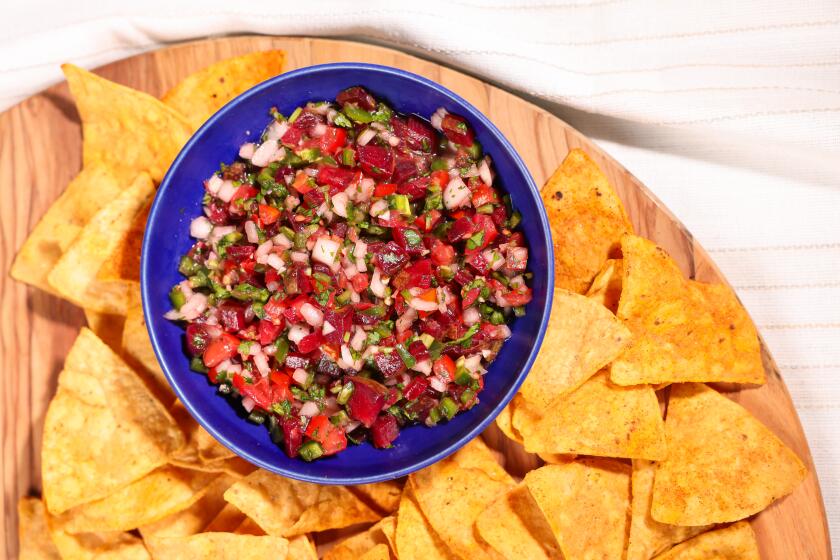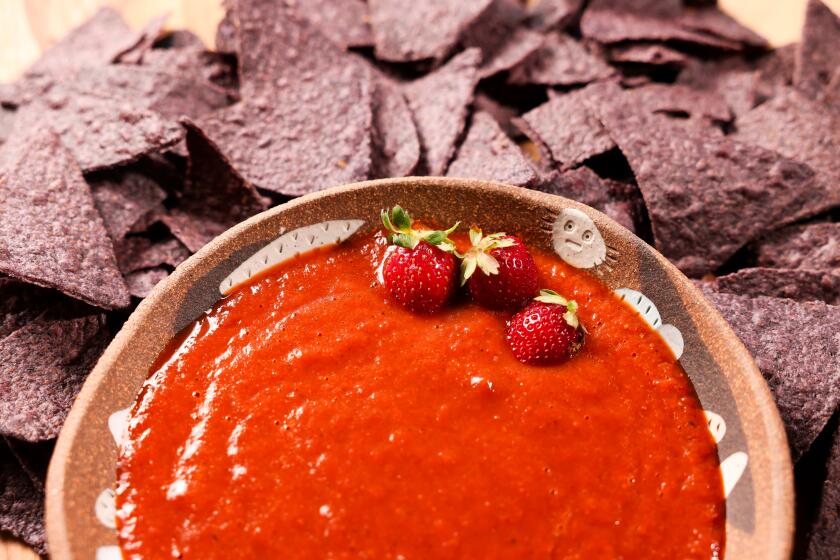
- Share via
Who gets to wag the proverbial finger at what should or shouldn’t play a part in a Mexican person’s kitchen or gastronomical expressions?
“Is cooking not an outlet for us to cultivate and bring our creativity to life with the resources we have at hand?” asks Ernesto Gonzalez, the documentarian behind the Instagram account Chapakatas, and purveyor of fresh nixtamal in Palmdale.
Consider fruit in salsa, which in the U.S. can be thought of as something bizarre, something that doesn’t quite belong in Mexican cuisine.
Plum Pico De Gallo
But bizarre wasn’t the emotion I felt late one night when one of my cousins, during a trip visiting my family in León, Guanajuato, took me to a taco shop called La Mina de Oro. A little tower of all kinds of salsas peered at us on the table. One of them was a chopped pineapple habanero salsa.
I eagerly put some on my chistorra taco, starring a fatty and richly spiced sausage. The bright and heat-laden salsa cut right through. Sweet and tart with spicy and savory. Fruit with salsa is something that just makes sense to my tastebuds.
Perhaps I owe this to the way I grew up in San Diego seeing mango and pineapple used in ceviche. It‘s a similar idea behind the mango salsa Alexa Soto included in her Mexican vegan cookbook “Plantas” — akin to a salsa bandera (pico de gallo) with the creamy addition of avocado.
The tartness of fruit takes on a playful role that flirts with the citrus in a lot of salsas, dancing with its heat. It’s why the chile-lime spice mix Tajín gets sprinkled on watermelon. And why chamoy paste, which gets its addictive flavor from pickled apricots, plums or other dried fruits, is drizzled on mango and works so well on most fresh-cut fruit, potato chips and the rims of chilled michelada glasses. When dried fruit is coated generously with spice blends, our tongues rejoice, and even salivate, at the meeting of sweet, tart and spicy.
It’s not a new concept.
Indeed, fruit is already a part of the classic salsa ensemble of tomato, citrus, chile and allium. Not only are citrus plants fruits, so are tomato, avocado and salsa’s main ingredient, chile. Mulli, Nahuatl for salsa, which is often directly correlated specifically to mole — a salsa of its own accord — also uses fruit. Though the mole of the pre-Hispanic period has adapted to postcolonial ingredients, many for generations have been made with dried fruit like raisins and prunes to create their rich and complex profiles.
Ancho Strawberry Salsa
They may not be the most common salsas you’ll find, but as Gonzalez says, “Fruit salsas have definitely earned their place in regional cooking.”
In Charapan, Michoacán, where his tias live, Gonzalez says they crush together salsas in molcajetes with manzana criolla, a local apple varietal, instead of or along with tomatillo. Where tomatillo cries with tartness, so do these apples.
“These alternatives played an indispensable role during trying times for many in the communities when typical ingredients were scarce or whenever people needed to make their food supply last,” adds Gonzalez on the role of fruits in salsas. “So for me, using fruits like apples, quince or even tsïtuni [wild tart blackberries] demonstrates yet another shining example of the ingenuity of our communities’ cooks.”
In Sonora, salsa company La Mezcla makes a papaya habanero salsa; in Tequila, Jalisco, salsa made with yellow plum is pounded down in the molcajete for tacos; and in Gonzalo Guzmán’s cookbook “Nopalito,” the salsa borracha calls for apple juice.
Take a porcine taco tour with the best al pastor, chorizo and chicharrón tacos from the 101 Best Tacos in Los Angeles guide.
Locally, one of my favorite taco shops in the city, Tacos 1986, with a delectable mushroom taco for vegetarians like me (and fungi lovers too), has a mahogany red salsa fresa (strawberry) on the salsa bar.
Fruit in salsa is here.
Gonzalez points out that fruit salsas are just one of many foods that demonstrate an intrinsic and often-missed element about what makes Mexican cuisine so alive: culinary creativity.
In my own kitchen I’ve added to the repertoire of fruit salsas with a red cherry or plum pico de gallo, inspired by stone fruit season, and a macerated strawberry ancho salsa inspired by Tacos 1986 and Flamingo Estate’s limited-edition dried guajillo strawberries — a luxury candy reminiscent of Mexican dried fruit covered in chile.
Their dallying tartness charts an ongoing conversation on the renowned love affair of sour and spice in Mexican cuisine — one worth celebrating.
More to Read
Eat your way across L.A.
Get our weekly Tasting Notes newsletter for reviews, news and more.
You may occasionally receive promotional content from the Los Angeles Times.













